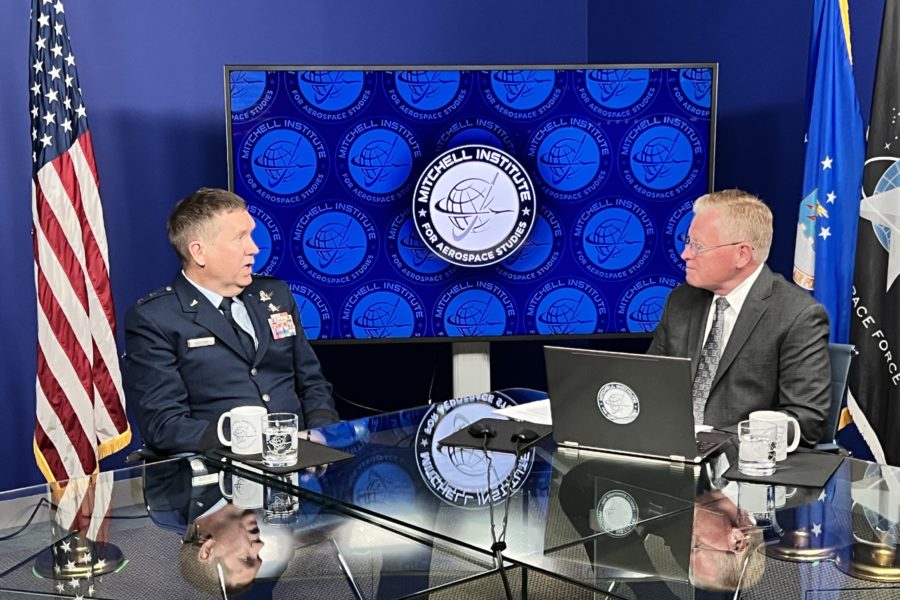Whether it’s adding on-orbit capabilities or new forms of simulation, the Space Force wants to get its training beyond the classrooms and PowerPoint slides, its chief trainer said May 10.
How the Space Force goes about preparing Guardians has changed significantly even within the past few years, said Maj. Gen. Shawn N. Bratton, head of Space Training and Readiness Command (STARCOM). His plan to upgrade USSF’s test and training infrastructure closely mirrors priorities laid out by Chief of Space Operations Gen. B. Chance Saltzman, who has emphasized that need since before he became CSO.
“We’re shifting back a little bit more to live training,” Bratton said during an appearance with AFA’s Mitchell Institute for Aerospace Studies. “As I came up in the classroom, we had some simulation capability, but there was really a lot of education. It wasn’t as much as what today I would call training activities. We learned about the space domain, we learned how to operate, but most of it was classroom discussion, seminar style, PowerPoint slides, all the standard things.”
Not anymore. “Now the discussion is, ‘Why aren’t we flying a spacecraft in training? Why aren’t we getting some sort of reps and sets, some sorties in, in the training environment?’” Bratton said. “And that alleviates some of the training burden that we placed on the operational units. If we can move that back into the training pipeline, I think there’ll be value added.”
For example, he cited the U.S. Air Force Academy’s FalconSat program, in which Cadets build, launch, and operate small satellites in orbit. Bratton said that experience teaches “all these fundamental concepts that apply regardless of what spacecraft you end up flying in your career.”
“We think we can bring that back into training through simulation, but also with some live activity,” he added.
Live Training
The Space Force’s emphasis on live activity is not without complications—unlike the other military services, it cannot establish a defined area of space solely for testing and training.
“There’s no sovereignty in space, and so we had to think about that a little bit different on how do we do these activities that we need to do to build the credibility of the force, to increase readiness, but also be safe and professional in our operations in the space domain,” Bratton said.
USSF’s overarching answer has been the National Space Test and Training Complex (NSTTC), a collection of sensors and assets on the ground and in orbit. Bratton credited Brig. Gen. Todd R. Moore, his deputy, for this description: “It’s the gym where we go to work out the force,” Bratton said. “We’re building that right now. And there are already pieces that exist. We’ve done some live activities, both on orbit as well as in the electromagnetic spectrum.”
The Space Force has executed two “Black Skies” exercises, the most recent one completed in March. Black Skies are part of a series of exercises designed to mimic the Air Force’s “Flag” exercises. The next iteration, “Red Skies,” focusing on orbital warfare, will take place late this summer, Bratton said.
To exercise command and control, the Space Force conducted “Polaris Hammer” in February, which focused in particular on the new Space Forces Indo-Pacific command.
STARCOM. meanwhile, continues to build out NSTTC, Bratton said, including “on-orbit capabilities, the ground sensors, and then the infrastructure that ties it all together for command and control and gathering the data, which is particularly important for the test enterprise.”
Virtual Training
Digital twins—highly accurate models that can be used for simulation and training—are a part of STARCOM’s training plan, enabling the Space Force to practice skills without creating real-world problems in space. But Bratton said his command is also working on “How we bring in existing spacecraft that don’t have a digital model.”
For those situations, collecting high-fidelity data must be gathered to generate realistic simulation models, leveraging Space Force intelligence to assist with developing realistic threats.
“Some of that exists today,” Bratton said. “I wouldn’t presume to say that we’re all the way there [though]. We’re getting a lot of help from industry in this area. But there’s a lot of work to do.”

